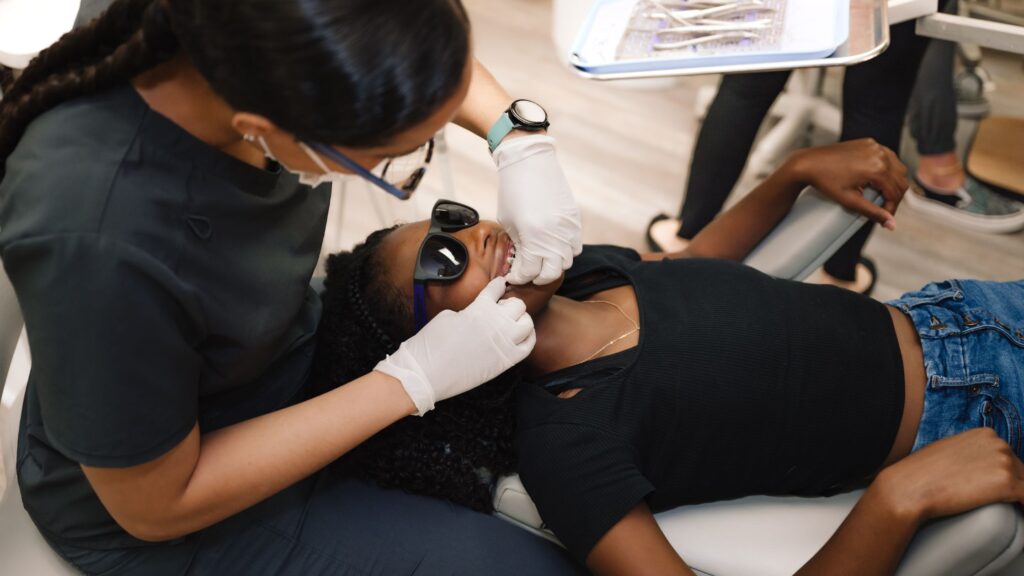While there are a number of different tooth realignment methods available today – including clear braces and Invisalign® aligner trays, traditional metal braces are still the most popularly used method.
Metal braces are much more advanced and complex than most people realize. They have many components, all of which are important in moving your teeth into the proper position.
Here are the basics you need to know as to how braces work, what each component of a metal braces system does, and what wearing braces can ultimately accomplish.
Why Wear Metal Braces? What Can It Accomplish?
There are numerous types of tooth misalignments, called malocclusions by dentists, that wearing metal braces can correct.
For example, your upper teeth might overlap your lower ones (overbite), or you might have the opposite problem (underbite). There might be too much space between teeth (spacing) – or not enough (crowding).
Sometimes, teeth may come in crooked, tilted up or down to a degree. Other times, teeth simply don’t lie down straight against one another when they are touching (mouth in closed position.)
All of this affects the way you bite, chew, and speak. And it affects the way your smile looks. Braces are the most tried and true way to correct all these malocclusions and more.
What Does Each Metal Braces Component Do?
Let us “dissect” metal braces for a moment, looking briefly at what are the constituent parts of the system and what the purpose is of each of these components.
- Metal brackets. These are the heart and soul of metal braces. One bracket is attached to each tooth to be moved by means of a dental bonding agent and/or orthodontic bands. Most brackets are made of stainless steel, though some are colored to match your tooth enamel.
- As mentioned above, special bands are sometimes used to help hold brackets to teeth. These bands wrap all the way around each tooth. The bands may be metal or ceramic. Some are clear or tooth-colored. If bands are used, small spacers may be used between teeth to allow room for the bands to fit properly.
- Archwires. Archwires attach to the metal brackets and are usually made of metal. They run along the brackets horizontally and create pressure and a track that pulls teeth in the desired direction slowly over time.
- Metal ties attach the wires to the brackets. Some braces systems also use rubber bands to help attach brackets to wires.
- The wires are attached to an anchoring point somewhere in the back or your mouth.
- A buccal tube on the final tooth helps to keep the wire in its proper position.
- “Headgear” is sometimes used with metal braces. This gives additional pressure and is especially used to move back molars and to create more space when your teeth are too crowded.
Putting It All Together – How Does the System Work?
It all begins when your orthodontist examines your teeth, jaw, and mouth and interviews you to discover what sort of teeth misalignment problems you may be experiencing. Then, when you decide that metal braces are the treatment option for you, he or she will set an appointment and install the whole system.
All of the various parts of braces amount to a three-part plan: anchor the wire, attach the wire to brackets which are firmly attached to teeth, and then gently pull those teeth into proper position over a period of months or years.
Every month or so, you will need to see your orthodontist so he/she can assess how well your teeth are progressing and adjust the system as needed. This generally means tightening the wires, but it could mean loosening wires, adjusting ties and rubber bands, reattaching a bracket that is coming loose, or cleaning your teeth. It’s just a matter of whatever is needed.
You may well need to wear metal braces for one to three years. Treatment time varies greatly based on the severity and type of malocclusion. After treatment is complete, you generally need to continue to wear a retainer to permanently “retain” the successful results of wearing braces.
Millions upon millions of people of all ages and with a wide variety of tooth misalignment problems have benefited by wearing metal braces. There is no reason you can’t do so as well.
To learn more about metal braces, how they work, and whether or not they are right for you, contact Beauchamp Orthodontics in Central Florida today! We can give you a free initial consultation, schedule you for an in-person exam, and answer any and all of your braces-related questions.



